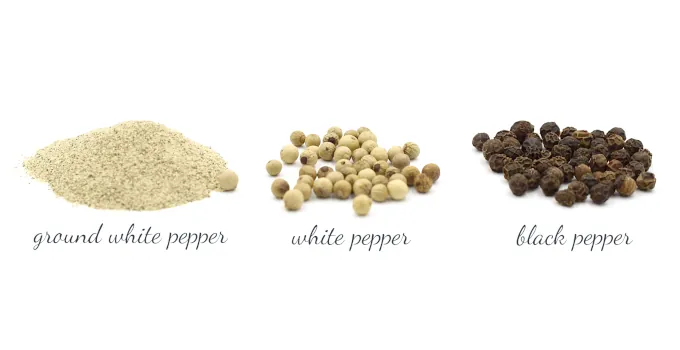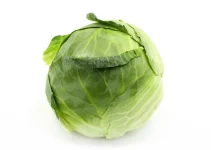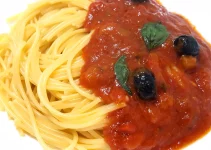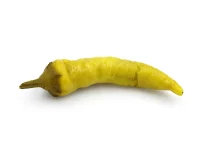The chances are that if you’re trying to find a substitute for white pepper it might mean that you’re trying to make a Chinese dish.
Throughout my many years of experimenting with different cuisines, I have noticed that in Chinese cuisine white pepper is more frequently used than black pepper.
Thai dishes also use it but my impression is that definitely not as much.
I’ll also make a quick confession: even nowadays I’m not completely won over by the taste of white pepper.
My first experience with it took place many years ago when I bought a grinder with peppers in all colors (green, red, black, and white) and I noticed something distinct about it. It was both in terms of smell and taste. I managed to figure out that it was the white peppercorns that were distinct.
Table of Contents
Best Substitutes for White Pepper
Can we find the perfect substitutes for white pepper? I will have to say that there’s no perfect substitute when it comes to this spice.
White pepper has a unique flavor, color, and smell. You can replace it but the results will be slightly different. Let’s see what we can use as substitutes.
1. Black Pepper: Best Substitute for White Pepper
The thing with using black peppercorns as a substitute is that if you’re looking to make a light-colored dish, the black specks will definitely stand out, while white pepper would have blended and vanished from sight. If you don’t have a problem with that, then it’s great.
However, if you want to find a substitute for white pepper because you don’t like the taste, you can simply use black pepper instead.
Moreover, you must be aware of one single difference: black peppercorns are spicier.
If you don’t like spicy food at all, start by adding just a bit when making the substitution.
The beauty of using pepper in any food is that you can add it even after it’s done cooking and you can use as much or as little as you’d like.
You can use black pepper either in powder form if you want it to blend in really well with the rest of the ingredients or you can use it freshly ground if you enjoy the more intense aroma.
The powder one is not as intense, not as fragrant and even not as spicy.
On the other hand, if you still want to include white pepper in a recipe but you don’t want it to be too intense, combine the white pepper powder with a bit of black pepper powder and you’ll have a more interesting mix, certainly a delicious one from my point of view.
2. Multi-color pepper blends (rainbow peppercorns)
You can even use a pepper grinder that contains various peppercorns: white, black, red, pink, green. These are also known as rainbow peppercorns and they look gorgeous.
That will be an interesting mix and you won’t feel the flavor of the white peppercorns quite as strongly.
I would say that using multi-color blends will be the best option for those who don’t like the taste of white pepper all that much.
With multi-color pepper blends, we get the taste of white pepper but we also get the flavor of black, red, pink, green peppercorns.
However, if you’re making an all-white dish, the specks of black, red, pink, green will stand out in the dish. For me, that’s necessarily a bad thing. I think it can create a beautiful blend.
Nevertheless, you must also consider that buying a multi-color blend of peppercorns can be slightly more expensive than buying a bag of whole black peppercorns or a bag of ground black pepper powder.
3. Can you use ground ginger as a substitute for white pepper?
I can’t say that the 2 have much in common, although I prefer ginger, if we were to pick out favorites.
The good thing about using ground ginger as a substitute is that it’s not as powerful in its flavor as fresh ginger. It retains a bit of sweetness and pepper spice but it’s more mild. That’s why it can work as a replacement in some dishes.
You can use ground ginger ginger in white, creamy sauces and some soups and even stir-fries.
However, if we’re talking about one of the most famous dishes where white pepper certainly acts as one of the leading spices, that lends its special flavor to the overall dish, that would be hot and sour soup.
It’s a recipe that also calls for both dark soy sauce and light soy sauce and so many other fascinating ingredients. I wouldn’t call it easy to make and I wouldn’t substitute much when it comes to these kinds of recipes.
I wouldn’t use ground ginger in that kind of situation to replace the white peppercorns. At most, I would make a mix between white and black peppercorns to act as a substitute for white pepper.
4. Pink peppercorns
Can we find more beautiful peppercorns than the pink ones? I don’t think so. I also have some info that might surprise you when it comes to these colorful beads.
The first thing I should mention is that pink peppercorns are a spice that aren’t true peppercorns. They’re genetically closer to a cashew than the pepper spice family.
They’re the fruit of two trees in the Schinus genus: S. molle (Peruvian pepper) and S. terebinthifolius (aBrazilian pepper).
Pink peppercorns have a papery covering surrounding a central seed. That’s why they’re fruits, just as we call peppers and tomatoes fruits.
The fact that they’re fruits should give us an indication that the taste of pink peppercorns is sweet. They have a sweet fruity flavor, making justice to their resemblance to a dried berry.
Moreover, their heat is closer to chilis than black or white peppercorns.
If you don’t mind the pink specks in your food, pink peppercorns can work as a perfect substitute for white pepper. But you should expect a different flavor and a different sort of spice.
However, I believe that it’s harder to find pink peppercorns to buy than it is to find white pepper.
5. Green peppercorns
Let’s complete our list of peppercorns by also mentioning the green ones.
Green peppercorns are pepper in its purest state because they are freshly plucked from the vine of the plant when not yet ripe.
Thus, the green color.
But how does that influence the taste of the peppercorns when we compare them with black or white peppercorns? Let’s leave the pink ones aside because we saw that those are fruits for two very different plants. They have nothing to do with the Piperaceae family or Piper Nigrum.
Green peppercorns have a have a mild peppery flavor and a bright aroma.
Black peppercorns have stronger flavor and aroma. Green peppercorns have milder flavor and aroma.
The black ones are also a bit hotter.
All in all, the green beads have a fresher, fruitier flavor than white or black pepper.
That means that if you use them as a substitute for white pepper, you’re very likely to love the taste of green peppercorns.
You’ll also be interested to know that the green one is the original pepper used for steak au poivre and other classic peppercorn sauces.
6. Mustard powder (ground mustard seeds)
When we taste mustard greens, we get a peppery taste. The same goes for some other leafy greens in the mustard family.
However, how do ground mustard seeds taste?
Firstly, in powder form, the taste is not as pungent or potent as the taste of whole mustard seeds. We might be familiar with whole mustard seeds because some of us tend to use mustard seeds together with dill and black peppercorns to flavor pickles.
Overall, mustard powder is a flavor that adds a mild, spicy taste to dishes. It tastes like mustard so it’s definitely not my top favorite as a substitute for white peppercorns.
The advantage is that the yellow powder can blend more easily into certain dishes than the ground black pepper powder.
7. Turmeric powder
If you’re cooking curries often, you know that turmeric is the ingredient that makes them so loved by so many people.
Is turmeric powder a good substitute for white pepper?
Let’s consider the fact that turmeric be overwhelmingly earthy and bitter, almost musky, with a bit of peppery spice. It can have a slight ginger-like bite.
If you use it in small quantities, it can work as a substitute. Nevertheless, expect a completely different flavor.
And, depending on what you’re cooking, the color of the dish can change because turmeric powder has a bright yellow to deep orange that is often used as food coloring.
White vs Black Pepper: What Makes the Different Colored Peppercorns Different?
What sets these two apart besides the opposite colors? Are these two types of peppercorns a clear representation of yin and yang?
The main difference is established during harvesting.
Black pepper is made from unripe berries, harvested when they’re still green. These green berries are then dried until the skins are blackened.
White peppercorns are fully ripe berries, which are then soaked in water to ferment. The outer skin is removed before drying.
The skin is the one that contains piperine. Piperine is the component that offers the spiciness that makes black peppercorns so distinct in their biting quality but oh, so delicious.
That’s why white peppercorns are more mild, not as biting.
Their taste could be described as musty, grassy, and slightly fermented. Others even describe notes of ginger, although it doesn’t seem that way to me.
In terms of smell, white peppercorns have a bit of a medicinal smell, to me it smells of fermentation.
Black peppercorns can have a citrusy aroma, a fruity to citrusy taste and can smell woodsy.
Other varieties can taste of black tea, smoke, and wood.
There are many varieties around the globe and each will have its own distinct notes and flavors.
All in all, my favorite substitute for white pepper remains black pepper or an equal mix of white and black peppercorns but we can also use pink or green peppercorns or rainbow peppercorns if we want different flavors.




